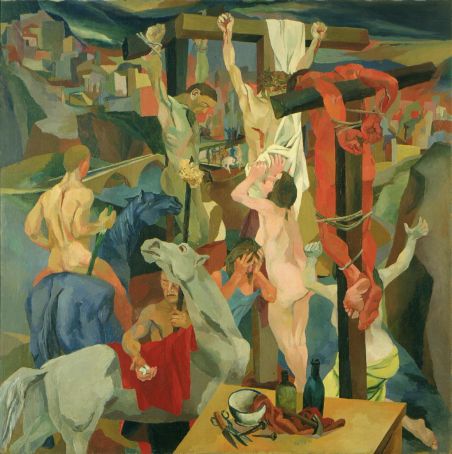The story of Crocifissione by Renato Guttuso.
This 1941 painting is considered a milestone in Italian 20th-century art and is among the best known works by the Sicilian painter Renato Guttuso (1912-1987).
It was commissioned by Alberto Della Ragione, an enlightened collector of works by Italian artists attached to the Corrente, an anti-fascist cultural movement based in Milan in the 1930s. A naval engineer from Genoa, Della Ragione used his vast wealth to support many young experimental artists, including Guttuso who viewed him as “a hero in a heroic moment for Italian art.”
When Della Ragione saw the finished Crocifissione, however, he was so stunned that he refused to let Guttuso part with it, insisting that such a masterpiece remain in the artist’s personal collection. In 1942, when Guttuso exhibited the enormous square canvas at the Premio Bergamo exhibition, it not only won second prize but also generated a storm of controversy.
Viewers were shocked by its widespread nudity, expressive nature and air of revolution. However it was the depiction of a naked Mary Magdalene that attracted the most criticism, particularly from the Vatican which declared the painting sacrilegious and labelled Guttuso a pictor diabolicus (devilish painter).
The artist’s atheist and communist credentials also saw his painting denounced by the fascists who claimed that it exploited religion to depict the horrors of war. The dramatic, richly-coloured crucifixion scene is made all the more graphic by the inclusion of instruments of torture: a hammer, large nails, a scissors and a knife.
The painting’s power to shock and its strong cubist elements recall Guernica, painted by Picasso a few years earlier; the influence is particularly evident in the horse whose head writhes back from the terrible spectacle.
Guttuso’s unusual composition also disorientates the viewer – most of the faces are obscured, including Jesus who is identifiable by his pierced side and crown of thorns. Guttuso claimed later that the painting’s lack of costume was not intended to provoke scandal but was his way of avoiding either an ancient or modern setting, describing it as a “tragedy of today.”
The painting must also be remembered in the context of its times. “This is a time of war,” Guttuso wrote in his diary, “Abyssinia, gallows, decapitations, Spain. I wish to paint the agony of Christ as a contemporary scene...as a symbol of all those who, because of their ideas, endure outrage, imprisonment and torment.” For the next five decades the controversial work remained in Guttuso’s private collection in Rome, according to the wishes of his venerated patron.
Della Ragione died in 1973 but not before donating some 260 paintings to the people of Florence as a gesture of solidarity following the city’s devastating floods in 1966, with the short but touching dedication to the Florentines: “I give you my life.”
In December 1986, a few weeks before he died, Guttuso summoned Italy’s culture minister and several witnesses to his home in Piazza del Grillo in Rome’s Monti district. From his deathbed the artist donated 11 of his most cherished paintings, including Crocifissione, to the Galleria Nazionale d’Arte Moderna (GNAM) where it can be seen today.
Article by Andy Devane
Photo: Roma, Galleria Nazionale d’Arte Moderna e Contemporanea. Su concessione del Ministero dei Beni e delle Attività Culturali e del Turismo.
General Info
View on Map
Rome painting: Crucifixion by Renato Guttuso
Viale delle Belle Arti, 131, 00197 Roma RM, Italy




















